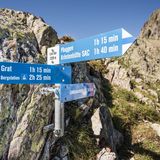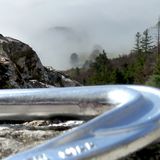
© davidschweizer.ch
Safety on via ferrata Ten useful tips
Via ferratas are a great opportunity to discover nature, share experiences, take on responsibilities and keep fit. The following advice will help you deal with any dangers you may have to face on a via ferrata.
These ten points are based on the recommendations made by the CAA and have been completed by the SAC training and safety experts. However, they can’t replace training courses, which provide a solid base and help you expand your competences and improve your technique with qualified instructors.
10 tips
1. Fit and healthy
Via ferratas demand strength and endurance. The intensity of the effort for the heart, circulation, muscles and articulations requires you to be in good health and able to assess your abilities. Avoid being pushed by time and adopt a pace which is suited to all the members of the group. NB If the level of difficulty is too high, it will be less enjoyable and you could end up in dangerous situations.
2. Careful planning
Planning is the key to a safe and successful experience on a via ferrata. As with all other mountain sports, via ferratas are graded. Find out about the level of difficulty, the length and the approach from guide books or online. The weather forecast is particularly important as storms, snow, wind and cold weather can greatly increase the risk of accidents and of getting stuck. Take note of the emergency mountain rescue phone numbers of the country (REGA 1414; European emergency number: 112).
3. Proper equipment
For maximum security on via ferrata, it is essential to use your equipment properly. You must have a harness, helmet and good shoes. Only use equipment which meets the agreed norms and ask for advice if necessary. Don’t forget sun cream, and leather gloves if you wish. Make sure that you take a first aid kit and a mobile phone with you – you’ll be happy to have them on you in case of an emergency.
4. Check your partner before starting
Always check each other’s equipment thoroughly. Make sure that the lanyards are attached correctly and check the harness, belay loop and the position of the helmet.
5. Check the cable and anchors
Rockfalls, the weight of the snow, ice and corrosion can all damage the via ferrata installations. Never attempt to climb a via ferrata which is closed.
6. Via ferrata with children
Check the route and length of the via ferrata. Very often, there is a minimum height requirement for participants. Children have a shorter reach and can easily be overcome when the hand and foot holds are too far apart. In exposed sections, it is recommended that you belay children (take a 20 m rope with you). NB When on a via ferrata, it is often difficult, if not impossible, to turn around and go back the way you came.
7. Never go out in storms and beware of rockfalls
Lightning can be fatal! Rain, dampness and cold weather increase the risk of falls. Rockfalls can also occur but moving carefully can help avoid this.
8. Keep a suitable distance
This rule is very important: there should never be more than one person between two fixed anchors.
9. Announce your intention when overtaking
Communication and anticipation help avoid dangerous situations when overtaking or passing someone. When possible, only overtake in appropriate places and make sure the other person agrees.
10. Respect nature
The mountains are a very precious place for discovering the uniqueness of nature. Appreciate this freedom and respect the fragile environment. Obey any restrictions, take your rubbish away with you and make sure that you are respectful towards others. Use public transport or car sharing.

